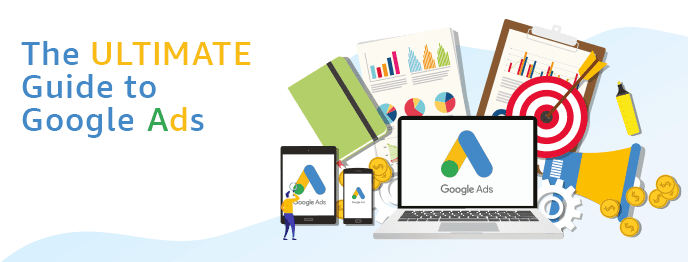You’ve probably heard of a little thing called Google. If you’re a business wanting to spend money on ads, then you might want to try posting those ads on Google, specifically, Google Ads.
This platform was created just 2 years after Google.com, aka the largest search engine in the world. And why would you not want your ads posted on Google? Chances are, you’ve probably clicked on some yourself, without even knowing it!
Why Google Ads?
Let’s first start with what Google Ads is. Google Ads is a paid advertising platform that uses a specific type of marketing, pay-per-click advertising, or PPC. This means you as the advertiser pays by the click or by each impression on an ad.
Google Ads also allows you to create and share ads through desktop and mobile devices that are well-timed and aimed at your target audience. Through these ads, your business will then come up on the search engine results page, and make sense for your audience as to why they came across it in the first place.
With Google Ads, you can drive real, qualified and specific traffic to your website all whilst they’re already searching for products or services like yours. You can also receive more in-store visits and more phone calls.
So, is Google Ads effective? Take a look!
- Google Ads have a click-through rate of nearly 8%.
- Display ads yield 180 million impressions each month.
- For users who are ready to buy, paid ads on Google get 65% of the clicks.
- 43% of customers buy something they’ve seen on a YouTube ad.
Best Practices on Google Ads
If you’ve already tried advertising on Google Ads and it didn’t work out so well, don’t give up! Many others have tried and failed, but for common reasons. Try some of our best practices below.
- Use a PPC Planning Template
Using a planner keeps your PPC projects organized. We recommend one by Hubspot and Google. With theirs, you can view how your ads will appear online, see your character counts, and be able to manage all your campaigns.
- Don’t Use Broad Keyword Terms
If your keywords are too broad, Google will be placing your ad in front of the wrong audience, which means fewer clicks and more spending on ads. Go look at what’s working, aka the keywords which are generating the most clicks, and then adjust them to match your ads with your target audience. It’s not common to get the mix perfect on the first try, and will take readjusting, adding, and getting rid of some keywords until you do.
- Make Sure Your Ads Are Relevant
If your ads aren’t matching what potential customers are looking for, (searcher’s intent) then spoiler alert, they’re not going to click on it! You also won’t get enough clicks to match the ad spend, so you won’t be getting your money’s value. Make sure that your headline and copy match the keywords you are bidding on, and make sure the ad itself is solving whatever problem a customer was looking for help with in the first place.
- Improve Your Quality Score (QS)
Your Quality Score, or QS, is how Google determines whether or not your ad should rank. The higher the ranking, the better your placements on the search engine results page. Google will tell you your score, but improving it is on you.
- Optimize Your Ad Landing Page
User experience is one of the most important aspects of web design, SEO, and yes, Google Ads. Think like the customer: what are they seeing when they click on your ad? What’s your website look like? Does your landing page use the same keywords as your ads?
Best Google Ads Terms to Know
Here is a short dictionary list of five of the best terms to know when using Google Ads:
- AdRank: determined by your maximum bid multiplied by your Quality Score.
- Bidding: Google Ads is a bidding based system, meaning you select the amount you’re willing to pay for an ad click. You have 3 options with this:
- CPC (cost per click, the amount you pay for each click on an ad)
- CPM (cost per mille, the amount you pay per 1000 impressions on an ad)
- CPE (cost per engagement, amount you pay when someone engages with your ad)
- ClickThrough-Rate: # of clicks you get on an ad as a proportion of the # of views your ad gets.
- Conversion Rate: Your landing page gives a seamless transition from the ad to it.
- Quality Score: measures the quality of your ad by your click-through rate, the relevance of your keywords, the quality of your landing page, and your past performance on the search engine results page.
How Does Google Ads Work?
Google Ads displays your ad to potential leads or customers who are interested in your product or service. Advertisers bid on search terms, or keywords, and the winners of that bid are placed at the top of search results pages, on YouTube videos, or on relevant websites, depending on the type of ad campaign selected. Other factors can impact your ads as well, such as Quality Score, AdRank, your location, keywords, and if your headline and your ad copy.
How to Use and Create Google Ads
It’s a pretty quick and easy process to set up your paid campaigns on Google Ads. Once you visit the Google Ads landing page, click “Start Now” and you’ll be redirected to a series of steps to help along the way. Make sure you have your images and ad copy created, because this will speed up the process.
Here are some additional steps to take once you’ve done the basics:
- Link Your Google Analytics
Google Analytics is a must have if you don’t already. It measures traffic, conversions, goals and unique metrics about your website. Linking this to Google Ads will make tracking and analyzing much easier and more accurate, plus you can view them all in the same place.
- Add UTM Codes
This sounds complicated, but UTM codes (Urchin Tracking Module) are used by Google to track any activity with a link provided. These are usually seen in a URL followed by the (?). UTM codes tell you which ad led to a conversion, making it easier to optimize your ads.
The trick is to add your UTM codes at a campaign level so you don’t have to do it manually.
- Set Up Conversion Tracking
This tells you how many customers or leads you’ve gotten from your ad campaigns. Without it, you’ll be guessing the ROI from your ads.
Google Ads isn’t something to be scared of. All it takes is a little research and some trial and error. Google Ads is a must for your paid marketing strategy, and without it, you miss out on hundreds, if not thousands of new opportunities or customers.

